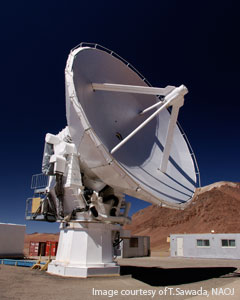About ASTE
Updated on 2024-10-01
Atacama Submillimeter Telescope Experiment - Overview

Located 4,800 meters above sea level at the Atacama Desert in Northern Chile, the Atacama Submillimeter Telescope Experiment (ASTE) is the state-of-the-art 10-m submillimeter telescope that observes submillimeter (0.1mm-1mm) wavelengths. ASTE has brought numerous new results by observing the center of our own galaxy, nearby star-forming regions, and distant galaxies. The extremely smooth telescope surface allows efficient submillimeter observations. The new telescope system allows astronomers to operate the telescope remotely even from Japan.
The ASTE project is promoted by Natiolnal Astronomical Observatory of Japan (NAOJ), the University of Chile, and many Japanese Universities - the University of Tokyo, Hokkaido University, Nagoya University, Keio University, Osaka Prefecture University, Ibaraki University and Joetsu University of Education. The two main purposes of this project are to explore the outer space visible from the southern hemisphere in submillimeter wavelengths down to 0.3 mm, as well as to develop and evaluate observational techniques and methods suitable for submillimeter observations. Following extensive instrumental studies, ASTE has successfully begun routine astronomical observations in 2004, mainly operating at the wavelength of 0.87 mm (350 GHz).
The ASTE site
The ASTE telescope is located in Pampa la Bola, which is 4,800 meters above sea level at the Atacama desert in northern Chile. The site is located approximately 10 km north of Chajnantor area which is the center of the ALMA site. The observing condition of the site has been studied by astronomers in detail since 1994. Because of its high atmospheric transmission of high frequency radio waves, it was found to be one of the most suitable sites for high quality submillimeter observations.
View what the ASTE site looks like
Probing the Dark Universe with ASTE
The southern sky has a lot of interesting astronomical objects - the center of our own Galaxy, the Magellanic clouds, and Eta Carinae, which is one of the most massive stars in the Milky Way. With great obseving capabilities and excellent conditions at Pampa la Bola, ASTE plays an important role in astronomy and astropysics through the observations of those objects in the submillimeter.
High precision antenna and receiving system
Astronomers have studied extensively to establish a high accuracy antenna required for submillimeter observations. The ASTE antenna has now achieved a relative pointing accuracy of 2 arcsec, and a high surface accuracy of 20 microns. The surface accuracy was improved by adjusting the 205 surface panels through a technique called "holography".
ASTE has an observing capability in two modes - one is spectroscopy and the other continuum imaging. The former is accomplished using superconducting mixer receivers, which are installed directly on the second Cassegrain focus of ASTE. The receivers are cooled to an extremely low temperature of 4 Kelvins (-269 degrees Celsius). The astronomical signals collected by the receiver then propagate down to the digital spectrometer, where up to 8 GHz of bandwidth is now available. For continuum observations, the AzTEC 1.1 mm-wave camera was installed on ASTE in 2007-2008. AzTEC is a 144-element bolometer array camera that allows efficient observations of a wide area of the sky. AzTEC has been developed at the University of Massachusetts in collaboration with researchers at Caltech, Cardiff, INAOE, Sejong University, and Smith College.
In addition, new receivers are upcoming. NRO, IoA, University of Tokyo, and Hokkaido University are promoting the development of a new three-color continuum camera, TESCAM, which uses the Transition Edge Sensor (TES) technology to observe the universe at 450, 850 and 1100 microns. Yamamoto lab at the University of Tokyo has been developing a pioneering receiver operating in the "Tera-Hertz" band (boundary region between radio and infrared), which successfully received the first light from celestial objects at 0.8 THz in 2011. Furthermore, the ultra-wideband digital spectrometer, WHSF, developed by researchers at Nagoya University and NAOJ will be ready soon, and increases the sensitivity at submillimeter wavelengths.
Visit Instrumentation overview for more details.
